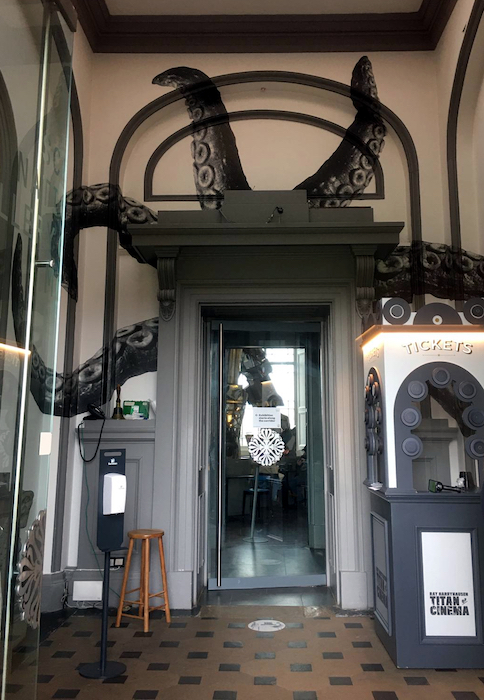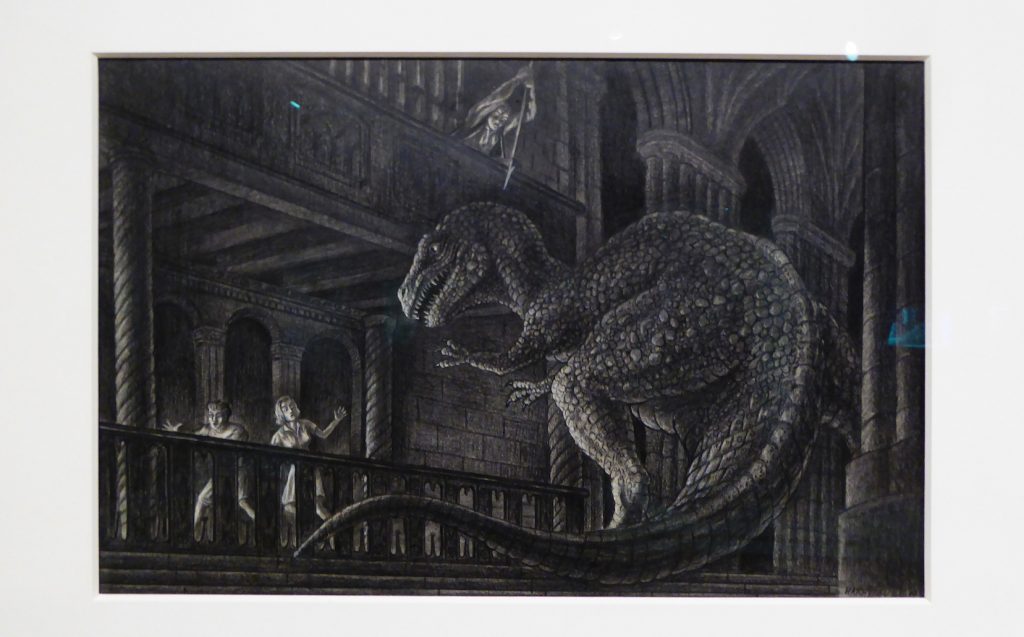
November in Edinburgh: if ever there was a season to nestle and perchance to (day)dream, this would be it. Outside the entrance of the National Gallery of Modern Art, standing in a socially-distanced line, I wait for my turn to visit the new exhibition “Ray Harryhausen: A Titan of Cinema”[i]. As vicious gusts of wind batter my coat, the prospect of seeking shelter in the glow of one’s imagination has an almost tangible appeal.
Of course, there is more than harsh climates that one might wish to escape. Growing up in California in the 1930s, Ray Harryhausen was, I suspect, not short of options. In a 1996 interview with John Tibbetts[ii], the master animator reminisces about his childhood: a lanky boy with few friends, whom everyone regarded as ‘a little bit unbalanced’, living through the aftermath of the Great Depression. Science fiction fuelled his imagination: he recalls taking the red streetcar to Pasadena, to go watch previews of ‘fantasy films’ with his pal, Ray Bradbury.
It wasn’t, however, one of those streetcar escapades with Bradbury that set him off on a career that would become the stuff of legends. As the curators of the Edinburgh exhibition make abundantly clear, the pivotal turning point in Harryhausen’s life was a 1933 screening of King Kong (1933, by Merian C. Cooper and Ernest B. Schoedshack) at the Grauman Chinese Theatre in LA. There, accompanied by his mother, a teenage Ray was transfixed by the artistry of Willis O’Brien, the special effect master who animated the great Kong. The entire first room of the display is dedicated to this foundational event. Among the objects on display, there is a page from Ray’s personal diary, dated May 1939. By that time, as Ray himself logged, he was in regular contact with O’Brien and had seen King Kong thirty-one times.
From that first room, the curators draw a path through the career of someone they aptly refer to as a ‘titan,’ a pioneer of model animation, whose output has fed the collective imagination for over three decades. Their effort is ambitious. After years in the making, and with the substantial involvement of the Ray & Diana Harryhausen Foundation, Titan of Cinema presents itself as a key point in the reassessment of Harryhausen’s legacy, building directly on the New York retrospective that MOMA dedicated to the artist shortly before he retired, in 1981.
As the visit unfurls, the audio-guide, narrated by American director John Landis, picks up key anecdotes and facts, while the stunning wealth of models, preparatory drawings, and storyboards that populate the rooms are left to fill the gaps.
In this way, we follow Ray’s lifelong fascination with the fantastic, starting with Jules Verne and Gustave Doré’s illustrations of Dante’s Comedy to his passion for dinosaurs. A carousel of creatures marks the various stages of his career, from the monster-on-the-rampage hits of the 1950s to the myth-inspired Sinbad films in the 1970s.
The diverse range of items conveys the scope and depth of Harryhausen’s craft. The preparatory drawings especially, such as those for Valley of the Gwangi (1969, by James O’ Connolly), give a sense of how Ray’s imagination encompassed the whole set, not just the models, and how deftly the film-maker could weave together disparate iconographies, architectures, and visual motifs, spanning across genres and traditions.

Other items showcased the technical ingenuity behind Harryhausen’s visual imagination, such as the brick gate of the Oakland ferry gate in San Francisco, destroyed by the octopus in It Came from Beneath the Sea (1955, by Robert Gordon), which Ray designed to crumble in an orderly and predictable fashion so that the model’s movement could be coordinated accordingly.
Throughout the display, Harryhausen’s fascination and affection for his creations shine through. It is difficult to repress a swell of sympathy for the young man lovingly holding a devil marionette in a photograph from 1935. Beyond that, some obscurity remains. Not much is said of Ray’s inclinations, temperament, or indeed his biography. The few details we are given (his long collaboration with his parents, for example) end up reinforcing the impression of an artist bound to a somewhat secret world. Perhaps it is not by chance that his creatures are often outcasts who find themselves, through no fault of their own, desperately out of place in an alien environment, their actions and desires met with fear and hostility.

A paradigm begins to take shape: an imaginative talent, nurtured by sci-fi magazines and by a loving family nest, struck early on in his life by the power of the cinema to bring wonder to life. It is, of course, something of a cliché, and one that fails to answer legitimate critical questions. Even a superficial dip into cultural history will reveal the potent role of nuclear paranoia, social anxiety, and red scare in the collective unconscious of 1950s America, a matter on which the exhibition remains strangely silent. The import of Harryhausen’s close friendship with Bradbury is similarly not explored, nor is his interest in the past at a time, the late 1960s, marked by significant forward-looking momentum.
Rather, the curators are keen to spin a more conventional master-and-disciple tale, and indeed to draw a lineage: from O’Brien to Harryhausen to a plethora of present-day animators, such as Del Toro and Burton (name-checked, alongside many others, on a large wall in the final room of the display). This concern was also apparent in a talk by Peter Lord that accompanied the exhibition. Speaking on November 20th with curator Becky Manson, Lord, founder of Aardman Studios, told the audience about how significant it had been for Harryhausen to have shaken O’Brien’s hand as a young man, and how significant, in turn, it had been for himself to have shaken Harryhausen’s, years later. The entire history of model animation in two handshakes was the predictable quip.
As compelling as it may be, such a master-and-disciple lineage is ultimately limited in its ability to frame the full legacy of Harryhausen’s body of work. Take, for example, Rebooted (2019), a short film by Australian film-maker Michael Shanks screened only a few months ago at the Annecy festival[iii]. The short is a loving and bittersweet tribute to stop-motion animation and other ‘left behind’ techniques. In the short, one of Harryhausen’s skeletons, unable to get work in today’s industry, briefly indulges the fantasy of burning down the studio, before finding hope in the fact that at least children still respond to his magic. Shanks’ balance of cynicism and nostalgia points, I believe, to a larger issue at play here, namely the state of the art.
Bluntly put, what the Edinburgh exhibition fails to deliver is an honest engagement with notions of artistry, craft, and authorship. These notions underpin the appeal of puppet animation, past and present, and the cultural currency of masters like Harryhausen, whose handiwork stands painfully out in an era where digital images crowd the screens, and by extension our collective imagination. Against this backdrop, celebrating Harryhausen’s ability, as an individual artist-creator, to weave together heterogeneous visual traditions and inject them back into popular culture, is not so much a recognition of mastery as it is an acknowledgment of loss. This is the critical legacy, and in a sense the challenge, that Ray Harryhausen has left us: a challenge with which both contemporary animators and critics must contend.
PM Cicchetti is a film writer and scholar based between Bologna and Edinburgh. He is a regular contributor to a number of film magazines in Italy, Switzerland and the US, and has held lecturing posts at various universities in Scotland since 2012. His research focuses on the semiotics of culture: his doctoral thesis studied the legacy of Puritan discourse and Western mythologies in American cinema during the early years of the Obama presidency. For recent updates on his writings and musings, visit http://pmcicchetti.eu
[i] “Ray Harryhausen: A Titan of Cinema” is on display at the Scottish National Gallery of Modern Art until September 5th, 2021.
[ii]John Tibbetts, “The Bradbury Chronicles,” chap. 3 in The Gothic Imagination. Conversations on Fantasy, Horror and Science Fiction in the Media (New York: Palgrave Macmillan, 2011).
[iii] For more remarks from Annecy, see PM Cicchetti, “The Third Song on The Record. The 60th Annecy International Animation Film Festival,” Film Criticism 44, no. 3 (2020), doi:10.3998/fc.13761232.0044.307.
